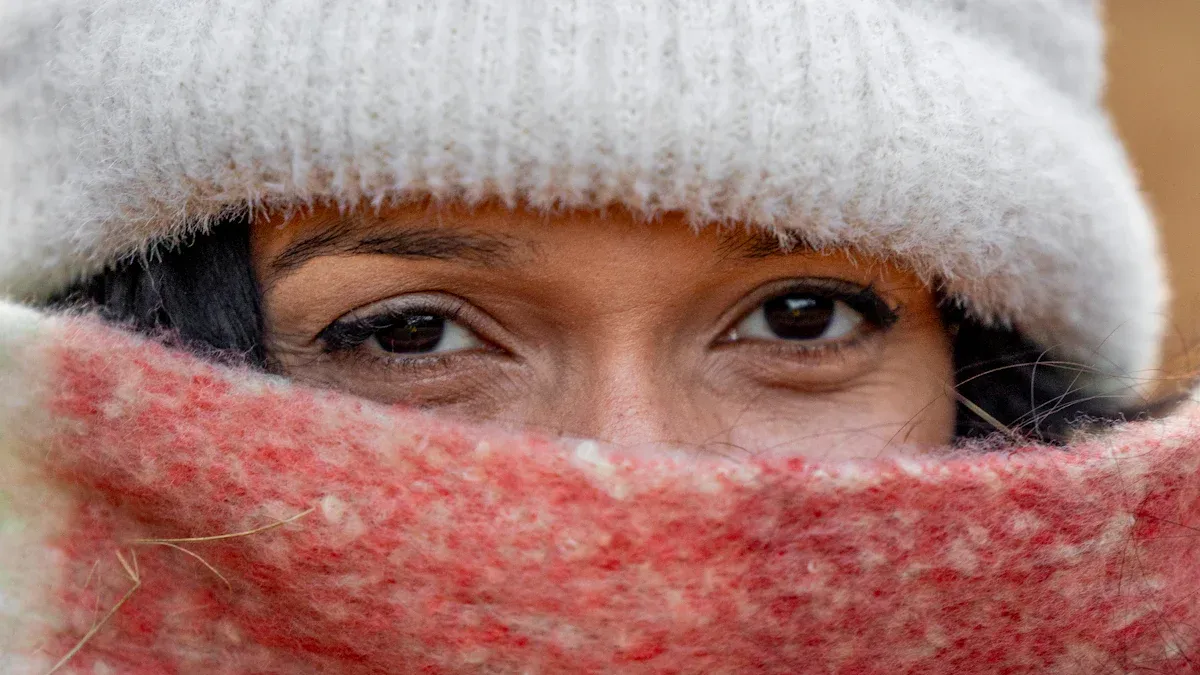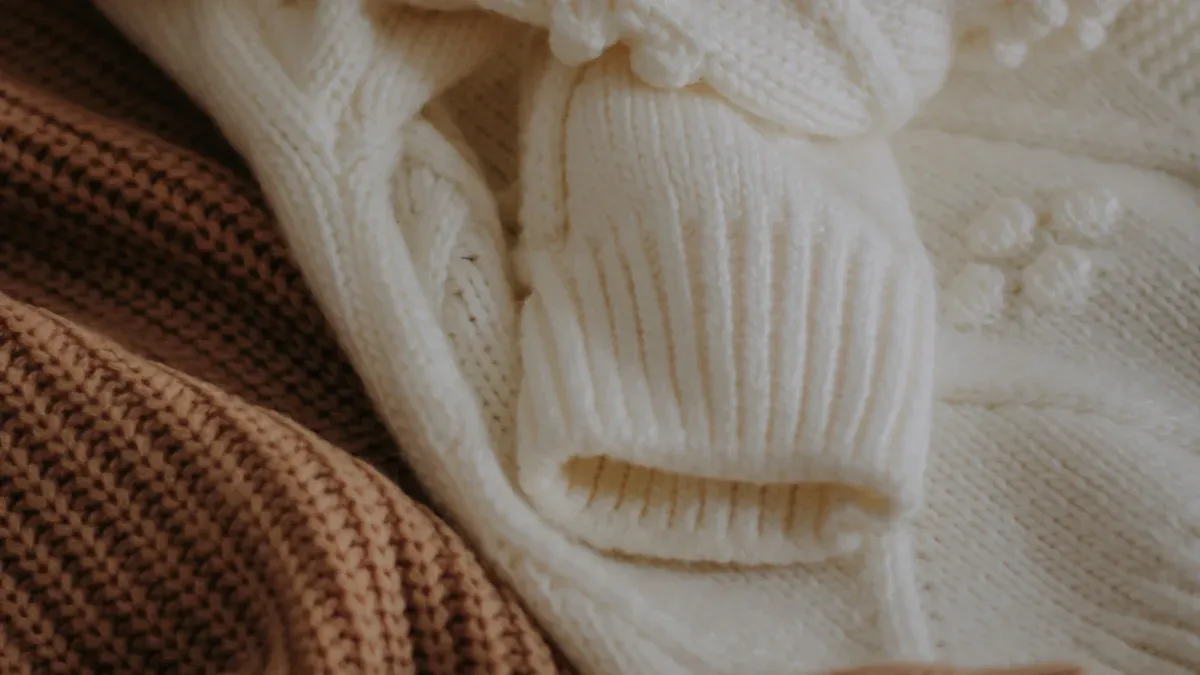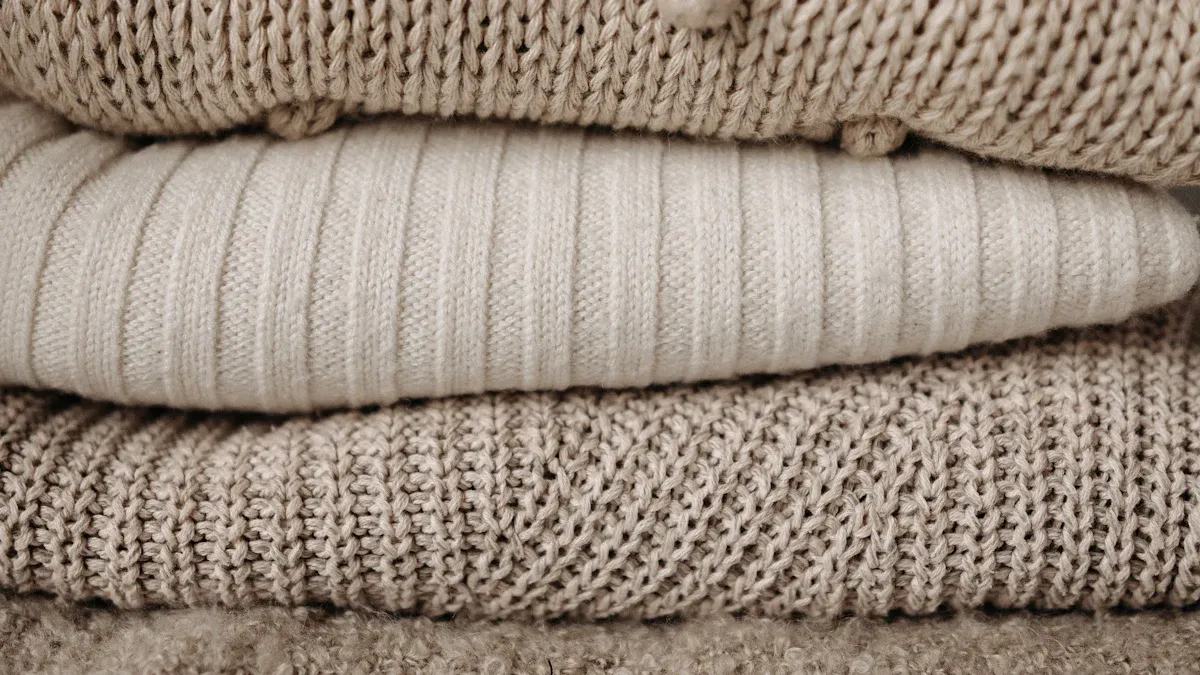
When it gets very cold, luxury knit fabrics keep you warm and comfortable. The best types are Merino wool, Icelandic wool, cashmere, alpaca, vicuña, camel wool, double knits, fleece, and silk blends. Wool is great because it is warm, strong, and keeps sweat away from your skin. Cashmere and alpaca are soft and keep you warm, but you must take extra care of them. Many luxury brands use these fibers in winter clothes because they last long and look nice.
Key Takeaways
Luxury knit fabrics like merino wool, cashmere, and alpaca help you stay warm, dry, and comfy in very cold weather. – Pick tightly knitted fabrics and wear layers to hold in heat and control sweat for more warmth. – Soft, hypoallergenic fibers like merino wool and alpaca are good for sensitive skin and stop itching. – Take care of your knits by washing them gently, drying them flat, and storing them the right way to keep them soft and lasting long. – Do not use synthetic fibers because they trap sweat and lose their shape; natural luxury knits give better warmth and let your skin breathe.
Best Luxury Knit Fabrics

Merino Wool
Merino wool is a very popular luxury knit fabric for extreme cold. It feels soft and bends easily. Merino wool fibers have a crimp that makes tiny air pockets. These pockets hold warm air close to your body. This helps you stay warm, even when it is freezing outside. Merino wool keeps you warm even if it gets wet. It moves sweat away from your skin to the outside. This keeps you dry and comfortable. Merino wool has lanolin, which helps stop bad smells. This makes it a good pick for long winter days.
Tip: Merino wool is great for base layers, sweaters, and hats. It helps control your body temperature and fights odors.
Air pockets give natural insulation
Pulls moisture away and dries fast
Soft and comfy for sensitive skin
Helps stop odor and bacteria
Icelandic Wool
Icelandic wool is well known for keeping you warm in very cold weather. The fibers are crimped and folded, making lots of tiny air pockets. These air pockets block the cold and keep you warm. Icelandic wool is one of the warmest pure materials you can get. The thick fibers add even more warmth. Studies show Icelandic wool holds heat better than regular wool, cotton, or polyester.
Keeps in heat in extreme cold
Thick fibers give extra warmth
Breathes well for comfort
Cashmere
Cashmere is famous for being soft and warm. The fibers are much thinner than regular wool, only 14-19 microns. This makes cashmere feel gentle on your skin. Cashmere gives almost eight times more warmth than sheep wool. You stay warmer without wearing heavy clothes. Many people like cashmere because it feels light and looks fancy. Alpaca wool can be a bit warmer, but cashmere is still a favorite for softness.
Very soft and light
Very warm without being bulky
Keeps in heat very well
Note: Pick cashmere from brands that care about the planet and animals. Good cashmere protects nature and treats animals and workers fairly.
Alpaca
Alpaca wool is another great luxury knit fabric. It is softer than sheep wool and feels smooth and silky. Alpaca fibers have air pockets that trap heat. This gives you great warmth. Alpaca wool is lighter than sheep wool, so it is comfy to wear for a long time. Alpaca wool does not have lanolin, so it is hypoallergenic and good for sensitive skin. Alpaca can soak up to 30% of its weight in water and still feel dry. This keeps you warm and dry.
Silky, smooth feel
Great warmth and light weight
Hypoallergenic and gentle for sensitive skin
Pulls moisture away well
Vicuña and Camel Wool
Vicuña wool is one of the rarest and fanciest luxury knit fabrics. The fibers are very thin, about 12 microns. This makes them softer and warmer than even the best cashmere. Each vicuña gives only a little wool each year. Clothes made from this wool are very rare and cost a lot. Vicuña wool is gathered in the Andes and helps local people. Camel wool is also loved for being warm and soft. Both types give great warmth and a special luxury feel.
Very soft and warm
Gathered in a way that helps local people
Fiber Type | Average Fiber Diameter | Warmth | Rarity | Price Range (per kg) |
|---|---|---|---|---|
Vicuña | ~12 microns | Highest | Very rare | |
Cashmere | 14–19 microns | Very high | Rare | $75–$85 |
Camel | 16–20 microns | High | Rare | $30–$40 |
Double Knits
Double knit fabrics are made with a special method that creates two layers at once. The inside layer feels soft and fits close to your body. The outside layer blocks wind and cold. The two layers trap heat between them, giving you more warmth. Double knits are strong and keep their shape. They are great for jackets, pants, and other winter clothes that need to be warm and tough.
Two layers for extra warmth
Strong and keeps its shape
Good for outerwear and heavy winter clothes
Tip: Some double knits mix in special fibers for better moisture control and comfort.
Fleece
Fleece is a favorite for active winter clothes. It holds heat well and feels soft on your skin. Fleece lets air move through and pulls sweat away. This helps you stay dry when you play outside. It dries faster than wool, so it is good if you sweat or get wet. Fleece does not keep you as warm as wool when wet, but it is tough and easy to wash.
Fiber Type | Thermal Efficiency | Moisture Management | Notes |
|---|---|---|---|
Fleece | Good insulation; traps heat | Hydrophobic; quick drying | Durable, less expensive |
Wool | Superior insulation; retains heat when wet | Excellent moisture-wicking | Better thermal regulation |
Breathes and dries fast
Good for layering in sports
Soft and comfy for most people
Silk Knits
Silk blends make luxury knit fabrics look and feel fancy. Silk is soft, light, and helps control temperature. When mixed with wool or other fibers, silk makes clothes stronger and helps them keep their shape. Silk blends feel smooth on your skin and help stop dryness in winter. These blends also give warmth, let your skin breathe, and look shiny and pretty.
Soft and gentle on skin
Controls temperature and keeps you warm
Makes knitwear stronger and last longer
Makes clothes look and feel more fancy
Note: Silk blends are good for base layers, scarves, and sleepwear. They give style and keep you warm.
Fabric Properties
Warmth and Insulation
You want your winter clothes to keep you warm. This is important when it is very cold outside. How warm a knit fabric feels depends on the fiber and how it is made. The way the fabric is knitted also matters a lot. Some knits, like rib and purl, hold more heat than plain knits. Tight knits keep more warmth in than loose knits. Honeycomb knits give even better insulation than single jersey or pique knits. Wool fabrics, like merino and cashmere, keep you warmer than silk or bamboo.
Tight knits trap more warmth than loose ones.
Honeycomb knits insulate better than single jersey or pique knits.
Wool, especially merino and cashmere, keeps you warmer than silk or bamboo.
Studies show that how the knit is made matters more for warmth than just the fiber. If you want the best insulation, pick thick, tightly knitted fabrics.
Softness and Comfort
Softness is important, especially if your skin is sensitive. Cashmere feels the softest because its fibers are very fine. Merino wool is also gentle and does not itch as much as regular wool. Silk and bamboo rayon are smooth and good for people with skin problems. These fabrics are hypoallergenic and let your skin breathe. Knitted fabrics stretch more and feel softer than woven ones. Modal and microfiber blends stay soft and comfy, even after many washes.
Cashmere: softest, feels very fancy
Silk and bamboo: smooth, hypoallergenic, breathable
Durability
You want your clothes to last for many winters. Merino wool and other luxury knits are very strong. They do not get little balls on them after washing. Most luxury knits get high marks for not pilling. Tight knits and special finishes help your clothes look new longer. Synthetic fibers, like polyester, make the fabric stronger and help stop wear.
Breathability and Moisture-Wicking
It is important to stay dry as well as warm. Different fabrics handle sweat in different ways. The table below shows how some popular fabrics compare:
Fabric Type | Breathability | Moisture-Wicking | Warmth/Insulation | Notes |
|---|---|---|---|---|
Cashmere | High | Good | Superior | Soft, lightweight, durable |
Silk | Moderate | Good | Moderate | Smooth, delicate, needs care |
High | Excellent | Low | Soft, best for mild weather | |
Knit Structure | Varies | Varies | N/A | Structure affects performance |
You get the best results when you pick luxury knit fabrics that balance warmth, softness, strength, and breathability.
Choosing the Right Fabric
Weight and Fiber Content
When you choose winter clothing, pay attention to fabric weight and fiber content. Heavier fabrics, like thick wool, keep you warmer in freezing weather. Lighter fabrics work better for mild days or indoor use. You can check the weight of baselayers by looking at grams per square meter (g/sm). Light baselayers start around 100 g/sm, while heavy ones reach up to 300 g/sm.
Wool gives you natural insulation, breathability, and odor resistance.
Silk keeps you warm and feels smooth on your skin.
Wool/synthetic blends, like NuYarn, add stretch and durability.
Darker colors and rich fibers help you stay warmer in winter.
Tip: Slim, simple layers fit well under jackets and help you stay comfortable.
Activity and Layering
Match your fabric choice to your activity. If you plan to spend time outdoors, layering helps you control your body temperature. Start with a soft baselayer that wicks away sweat. Add a middle layer for warmth, then finish with an outer layer that blocks wind and water.
Layering with luxury knit fabrics, such as silk blends or merino wool, helps you stay warm and dry. These fabrics trap heat close to your body but let moisture escape. This keeps you comfortable during sports, travel, or long walks in the cold.
Layer | Best Fabric Choices | Purpose |
|---|---|---|
Baselayer | Merino wool, silk, blends | Wicks moisture, keeps dry |
Midlayer | Cashmere, alpaca, fleece | Adds warmth |
Outer layer | Wool coatings, double knits | Blocks wind, keeps heat in |
Personal Preferences
Your comfort matters most. If you have sensitive skin or allergies, choose hypoallergenic fabrics like organic cotton, bamboo, silk, or pure cashmere. Merino wool is softer than regular wool and less likely to cause itching. Avoid coarse wool, acrylic, and heavy synthetic blends that can irritate your skin.
Look for sweaters with flat seams and tagless interiors.
Loose fits and smooth fabrics help prevent irritation.
Layer a soft, long-sleeved shirt under itchy sweaters for extra comfort.
Luxury Knit Fabrics offer many options for warmth, softness, and style. Pick the ones that fit your needs and feel best on your skin.
Care for Luxury Knit Fabrics

Washing and Drying
Luxury knit fabrics need gentle care to keep them soft and strong. You should always sort your knitwear by color and delicacy. Keep bright and hand-dyed items separate. Hand washing works best for most luxury knits. Use cool or barely warm water and a no-rinse wool wash, such as Eucalan Delicate Wash. Soak your garment for 20–30 minutes, then press out water gently. Never wring or twist the fabric.
If you use a washing machine, turn garments inside out and place them in mesh bags. Choose a hand-wash or delicate cycle with cold water. Remove the agitator if possible to reduce stress on the fibers. After washing, roll your damp knit in a towel to remove extra water. Lay it flat on a clean surface or blocking mat to dry. Shape the garment gently and keep it out of direct sunlight. Always let your knitwear dry completely before storing.
Tip: Avoid high heat from dryers. Air drying helps prevent shrinking and keeps fibers healthy.
Storage
Proper storage keeps your luxury knits looking new. Fold heavy sweaters and scarves to prevent stretching. Hang lightweight knits, like t-shirts, on padded or archival hangers. Store all knit fabrics in cool, dry places away from sunlight and heat. Use breathable garment bags made from muslin, not plastic, to stop moisture buildup.
Add acid-free tissue paper when folding to help keep the shape.
Place cedar blocks or lavender balls with your knits to keep moths away.
Clean your garments before storing to avoid stains and pests.
Preventing Damage
Luxury knits can get damaged by stretching, sunlight, tumble drying, and rough handling. Lay delicate items flat to air-dry. Skip the tumble dryer and avoid hanging heavy knits. Keep your clothes away from sharp jewelry and rough surfaces. Store your garments in cool, dry places with good airflow.
Cashmere needs extra care. Fold it instead of hanging. Spot clean small stains right away. Use breathable bags and moth repellents for storage. Professional dry cleaning helps prevent shrinkage and keeps your knits soft.
Note: Gentle care and smart storage help your luxury knit fabrics last for many winters.
What to Avoid
Synthetic Fibers
When you shop for winter knitwear, you will see many made with synthetic fibers like polyester, acrylic, spandex, or nylon. These materials cost less and feel light. But they do not work as well as natural luxury knits in very cold weather. Synthetic fibers can trap sweat and body heat. This makes you feel damp and cold, not warm and dry. Many synthetic knits also get fuzzy and lose their shape after a few washes.
Here is a simple chart to show the differences:
Fiber Type | Drawbacks in Extreme Cold | Advantages of Natural Luxury Knits |
|---|---|---|
Polyester | Not very breathable; traps sweat and heat; not biodegradable | Great insulation; keeps you warm even when wet; strong |
Acrylic | Not very strong; gets fuzzy easily | Soft, warm, hypoallergenic (like alpaca); feels fancy |
Spandex | Weakest; gets fuzzy fast | Very warm and comfy; natural fibers let skin breathe |
Nylon | Breathes better than polyester but not as well as natural fibers | Natural fibers give better warmth and comfort |
Tip: Pick natural fibers like wool, cashmere, or alpaca for more warmth, better breathability, and comfort that lasts.
Poor Breathability
Breathability is very important in freezing weather. Fabrics that do not let air move, like those with tight weaves or solid shells, trap sweat and moisture next to your skin. When sweat cannot get out, you start to feel cold and uncomfortable. Wetness lowers your body heat and makes it hard to stay warm. Cotton, for example, soaks up water and stays wet for a long time. This can make you feel cold in winter.
Breathable fabrics, like merino wool or silk blends, let sweat dry and keep you dry. They block wind and water but still let air move. You stay warmer and more comfortable because your skin stays dry.
Do not use fabrics that hold in moisture.
Choose knits that let your skin breathe and move sweat away.
Staying dry is just as important as staying warm. Breathable luxury knits help you do both in very cold weather.
Now you know which fabrics keep you warm in cold weather. Luxury Knit Fabrics such as merino wool, cashmere, and alpaca are warm and comfortable. They also look nice. Choose your fabric by thinking about your weather, what you do each day, and what feels good on your skin. Buying good quality clothes helps you stay warm and look stylish. You can make a small winter wardrobe or check out luxury brands for the best choices.
FAQ
What is the warmest knit fabric for extreme cold?
Vicuña wool keeps you the warmest in cold weather. Cashmere and Icelandic wool are also very warm choices. Merino wool is good for most winter days. You can wear more than one layer for extra warmth.
Tip: Pick fabrics that are tightly knitted to hold in heat better.
How do you stop luxury knits from pilling?
Wash your knits by hand or use a gentle wash cycle. Turn your clothes inside out before washing. Do not rub or twist the fabric. Lay your clothes flat to dry. Use a sweater comb or fabric shaver to take off pills.
Can you wear luxury knits if you have sensitive skin?
Yes, you can wear them. Merino wool, alpaca, and cashmere are soft and do not usually itch. Silk blends are also good for sensitive skin. Look for tags that say “hypoallergenic” or “for sensitive skin.”
Fabric | Skin Comfort | Hypoallergenic |
|---|---|---|
Merino Wool | Very Soft | Yes |
Alpaca | Silky | Yes |
Cashmere | Ultra Soft | Yes |
How do you layer luxury knit fabrics for outdoor activities?
Start with a base layer made of merino wool or a silk blend. Put on a cashmere or alpaca sweater as your middle layer. Wear a double knit or wool coat on top. This keeps you warm and dry outside.
Are luxury knit fabrics eco-friendly?
Many luxury knits use natural fibers that can be replaced. Some brands use safe and fair ways to make their clothes. Always check for labels like GOTS or OEKO-TEX before buying.
Note: Natural fibers break down faster than synthetic ones, so they are better for the earth.









